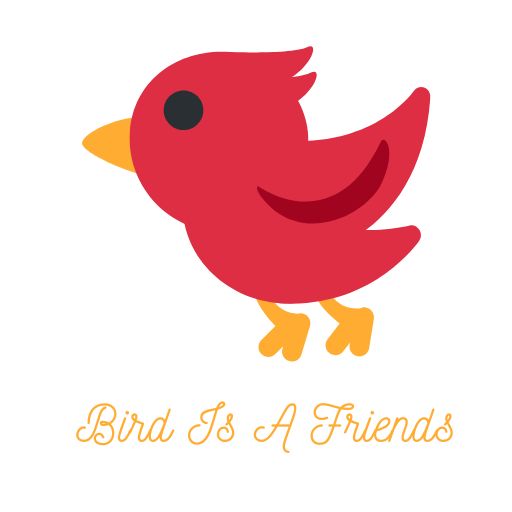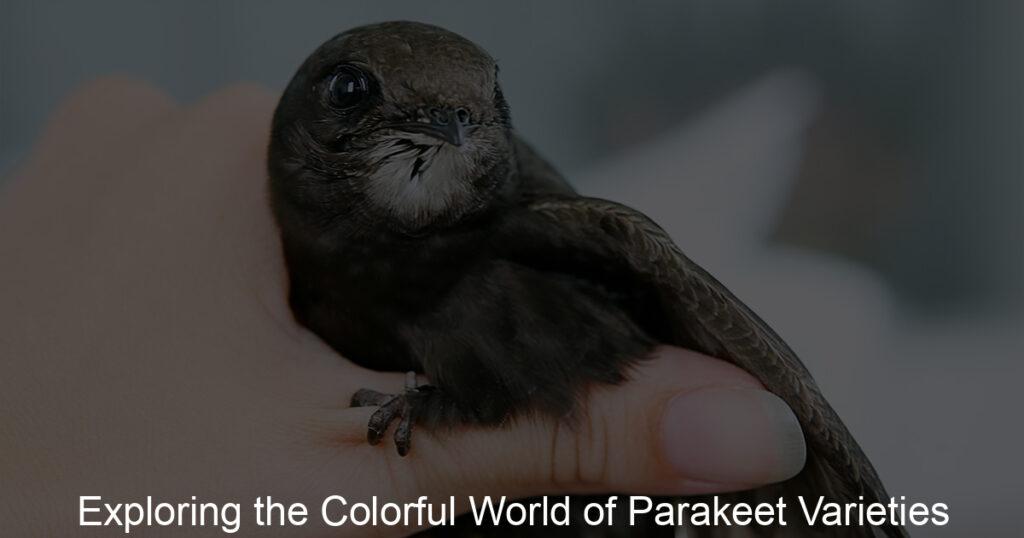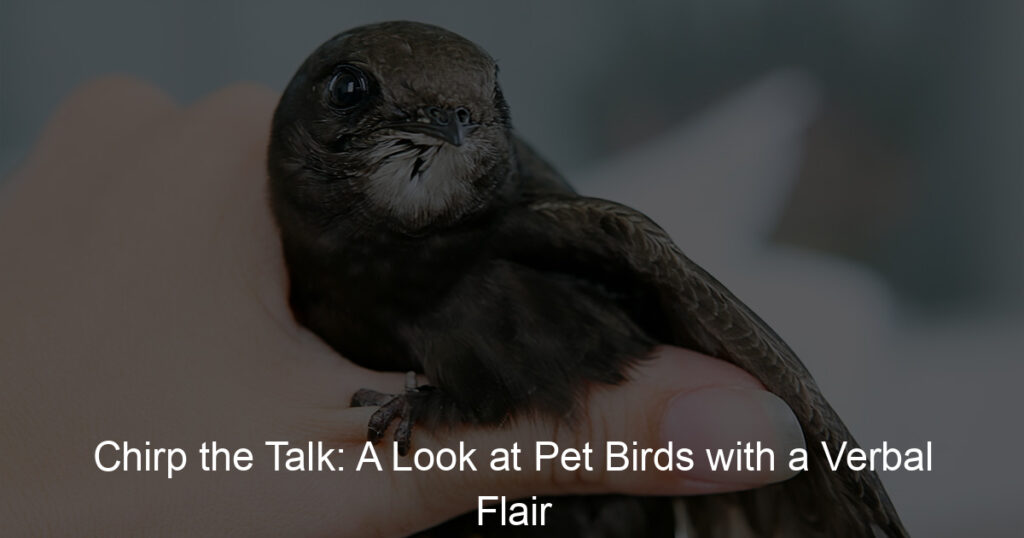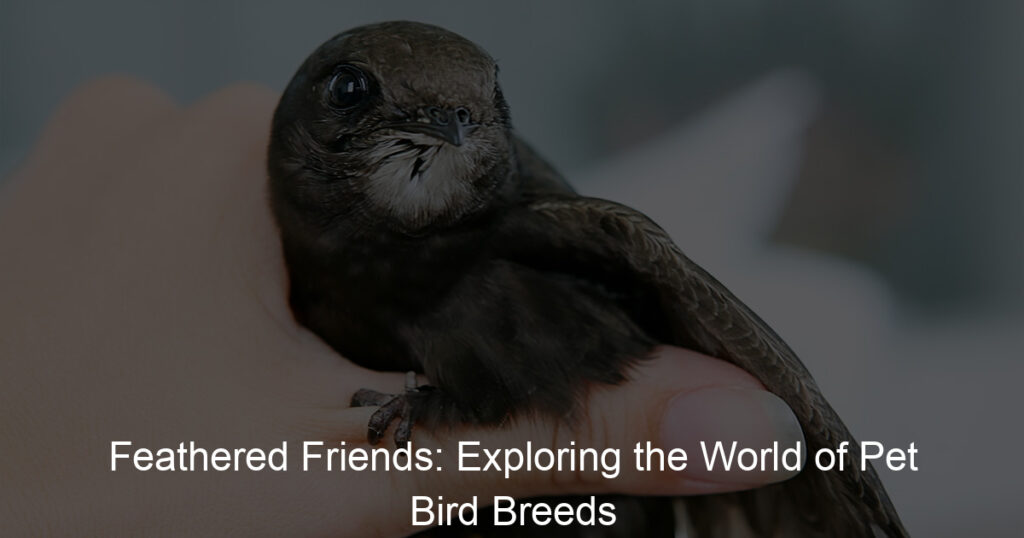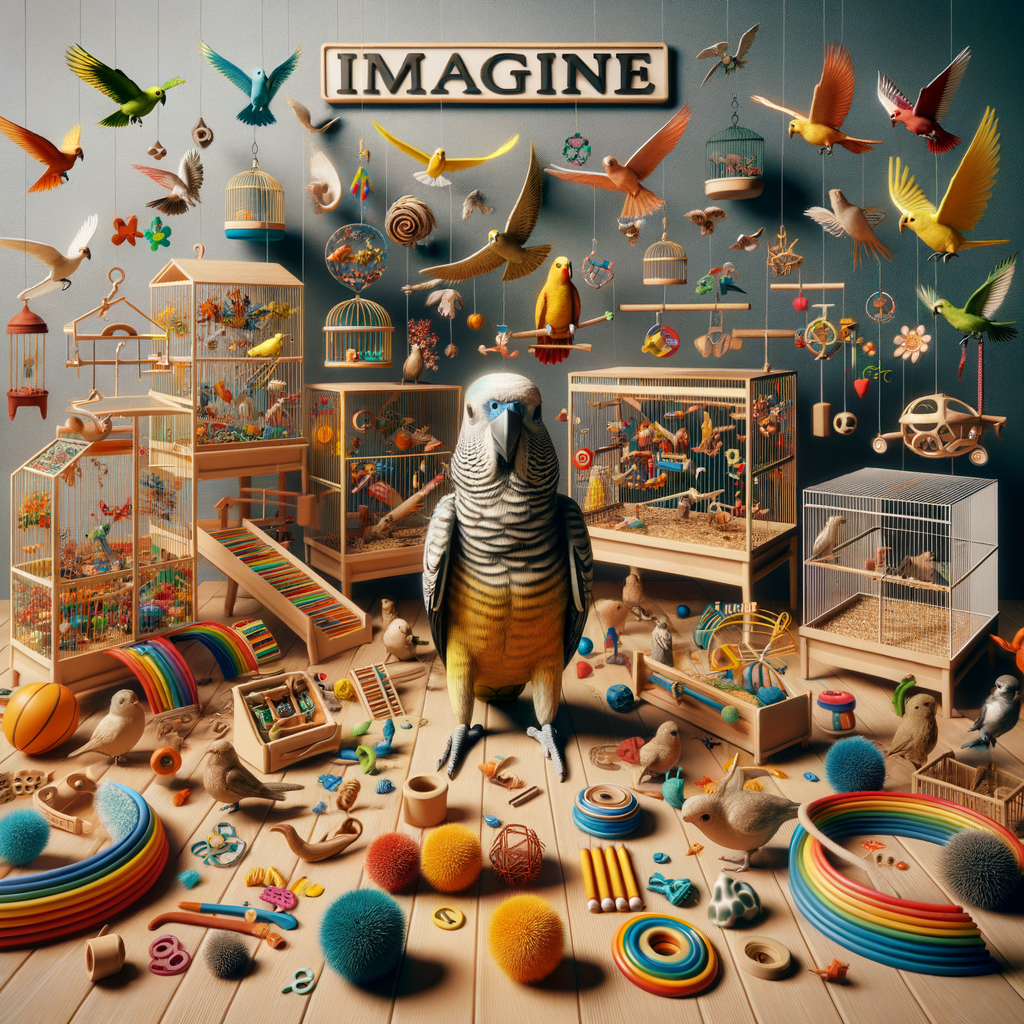
Introduction to Bird Toy Ideas
Just like humans, birds also need entertainment to keep them happy and healthy. The right toys can provide hours of fun and mental stimulation for our feathered friends. In this blog post, we will explore the importance of bird entertainment and how to understand your bird’s entertainment needs.
- The Importance of Bird Entertainment
- Understanding Your Feathered Friend’s Entertainment Needs
Entertainment is crucial for birds, especially those kept as pets. Birds are intelligent creatures with a high level of energy. Without proper entertainment, they can easily get bored and develop negative behaviors such as feather plucking and excessive noise-making. Toys provide a way for birds to exercise their minds and bodies, helping them stay active and engaged.
Every bird is unique, and so are their entertainment needs. Some birds enjoy toys that challenge their problem-solving skills, while others prefer toys that allow them to exercise and play. Understanding your bird’s personality and preferences is key to choosing the right toys. For instance, parrots are known for their curiosity and love for puzzles, so toys that require them to solve a problem to get a reward can be a great choice. On the other hand, canaries and finches love to fly and hop around, so toys that encourage these activities can keep them entertained.
In the following sections, we will delve deeper into the types of bird entertainment toys, tips and tricks to keep your birds entertained, how to choose the right toys for your birds, and some creative DIY bird toy ideas. So, stay tuned to ensure a happy, entertained bird!
Types of Bird Entertainment Toys
One of the most important aspects of bird care is ensuring that our feathered friends have plenty of entertainment. This section will focus on interactive bird toys, a popular choice for many bird owners.
Interactive Bird Toys
Interactive bird toys are designed to engage your bird’s mind and encourage physical activity. They come in a variety of forms and offer numerous benefits for your pet.
- Benefits of Interactive Toys for Birds
- Stimulate the mind: Birds are intelligent creatures and need mental stimulation to stay happy and healthy. Interactive toys can provide this stimulation, keeping your bird’s mind sharp.
- Promote physical activity: These toys often require your bird to move around, promoting physical exercise and helping to prevent obesity and related health issues.
- Reduce boredom and related behaviors: Boredom can lead to destructive behaviors in birds. Interactive toys can keep your bird entertained and reduce the likelihood of these behaviors.
- Examples of Interactive Bird Toys
Interactive bird toys can provide a wealth of benefits for your pet. They can help to:
There are many types of interactive bird toys available. Here are a few examples:
| Toy Name | Description |
|---|---|
| Puzzle Toys | These toys require your bird to solve a puzzle to get a reward, such as a treat. They are excellent for mental stimulation. |
| Foraging Toys | These toys mimic the natural behavior of birds in the wild, encouraging your bird to search for food. They can be filled with treats or your bird’s regular diet. |
| Activity Centers | These toys provide a variety of activities in one, often including ladders, bells, and mirrors. They can keep your bird entertained for hours. |
Bird Cage Toys
When it comes to keeping our feathered friends happy and entertained, bird cage toys play a crucial role. They not only provide stimulation but also promote physical activity and mental health. Let’s delve into the advantages of bird cage toys and explore some examples.
- Advantages of Bird Cage Toys
- Physical Exercise: Toys encourage birds to move around, flap their wings, and stay active, promoting physical health.
- Mental Stimulation: Solving puzzles or interacting with toys keeps birds mentally stimulated, preventing boredom and related behavioral issues.
- Beak Health: Chewing on toys helps maintain beak health, preventing overgrowth and other issues.
- Emotional Well-being: Toys provide comfort and reduce stress, contributing to a bird’s emotional well-being.
- Examples of Bird Cage Toys
Bird cage toys offer numerous benefits that contribute to the overall well-being of your pet bird. Here are some key advantages:
There is a wide variety of bird cage toys available in the market. Here are a few examples:
| Type of Toy | Description |
|---|---|
| Swings and Ladders | These toys encourage birds to climb and balance, promoting physical activity. |
| Chew Toys | Usually made of wood or rope, these toys help maintain beak health and provide a fun activity for birds. |
| Foraging Toys | These toys hide treats inside, stimulating a bird’s natural foraging instincts and providing mental stimulation. |
| Mirrors | Small mirrors can provide companionship and entertainment for birds, especially when they are alone. |
In conclusion, bird cage toys are essential for maintaining a bird’s physical and mental health. By understanding the advantages and exploring various options, you can choose the best toys for your feathered friend.
Keeping Birds Entertained: Tips and Tricks
Keeping your feathered friends entertained is an essential part of their overall well-being. Birds are intelligent creatures that require mental stimulation to stay happy and healthy. Here are some tips and tricks to keep your birds entertained.
- Rotating Toys for Variety
- Using Food as a Form of Entertainment
- Importance of Playtime Outside the Cage
Just like humans, birds can get bored with the same toys. To keep things interesting, rotate their toys regularly. This means removing some old toys and introducing new ones. This will provide a variety of stimuli and keep your bird’s interest piqued. For example, you can introduce toys with different textures, colors, and shapes to stimulate their senses.
Food is not just for sustenance; it can also be a great source of entertainment for birds. You can use food puzzles or hide treats in their toys to encourage them to forage. This mimics their natural behavior in the wild and provides mental stimulation. For instance, you can hide their favorite seeds in a puzzle toy and watch them figure out how to get it.
While toys inside the cage are important, it’s also crucial to allow your bird time outside their cage. This gives them a chance to stretch their wings, explore, and interact with their environment. You can set up a safe play area with toys and perches for them to enjoy. Remember, supervision is key during these playtimes to ensure their safety.
In conclusion, keeping your bird entertained requires creativity and understanding of their needs. By rotating toys, using food as entertainment, and providing playtime outside the cage, you can keep your bird mentally stimulated and happy.
How to Choose the Right Toys for Birds
Choosing the right toys for your feathered friends is crucial. It not only keeps them entertained but also contributes to their overall well-being. The size and species of your bird play a significant role in determining the type of toy that is suitable for them. Let’s explore how to choose toys based on the bird species.
Bird Toy Selection Based on Bird Species
Different species of birds have different needs and preferences when it comes to toys. Here’s a simple guide to help you choose the right toys for small, medium-sized, and large birds.
- Choosing toys for small birds
- Choosing toys for medium-sized birds
- Choosing toys for large birds
Small birds like budgies and canaries enjoy toys that they can easily manipulate with their beaks and feet. Lightweight toys made of softwood, plastic, or paper are ideal. They also love toys with bells or mirrors. However, ensure the toys are small enough to prevent them from getting trapped or injured.
Medium-sized birds such as cockatiels and conures require more durable toys. They enjoy toys that challenge their intelligence like puzzle toys. They also appreciate toys they can shred, like those made from cardboard or untreated wood. Avoid toys with small parts that can be easily swallowed.
Large birds like macaws and African greys need sturdy and robust toys. They have powerful beaks and enjoy toys they can chew and destroy, like those made from hard wood or thick rope. Large birds also enjoy toys that challenge them mentally, like foraging toys. Always ensure the toys are large enough to prevent choking hazards.
Remember, the safety of your bird is paramount when choosing toys. Always supervise your bird when introducing a new toy and regularly inspect the toys for any potential hazards. Happy toy hunting!
Bird Toy Selection Based on Bird’s Personality
Just like humans, birds have different personalities. Some are active and playful, while others are quiet and prefer solitude. Therefore, when choosing toys for your feathered friends, it’s important to consider their personality. Let’s explore how to select the right toys for active and quiet birds.
- Choosing toys for active birds
Active birds require toys that can keep them engaged and help burn off their energy. Here are some ideas:
- Exercise toys: These include swings, ladders, and ropes. They encourage birds to move around, promoting physical health.
- Puzzle toys: Active birds often enjoy a challenge. Puzzle toys that hide treats inside can keep them entertained for hours.
- Chew toys: Birds love to chew. Providing them with safe materials to chew on can help keep their beaks healthy and their minds occupied.
Remember, active birds can easily get bored, so it’s a good idea to rotate their toys regularly.
- Choosing toys for quiet birds
Quiet birds may not be as energetic, but they still need stimulation. Here are some toy suggestions for them:
- Mirrors: Many quiet birds enjoy looking at their reflection. A mirror can provide hours of entertainment.
- Soft toys: Quiet birds often enjoy cuddling with soft toys. Make sure the toy is safe for birds and doesn’t contain any harmful materials.
- Quiet bells: While loud noises can scare quiet birds, they might appreciate a soft bell that jingles when they touch it.
Regardless of your bird’s personality, always monitor them when introducing a new toy to ensure it’s safe and suitable for them.
DIY Bird Toys: Creative Ideas for Pet Bird Entertainment
Creating your own bird toys can be a fun and rewarding experience. Not only can you save money, but you can also tailor the toys to your bird’s specific needs and preferences. In this section, we will explore the materials you can use, easy DIY bird toy ideas, and safety considerations when making DIY bird toys.
- Materials you can use for DIY bird toys
There are many materials you can use to create DIY bird toys. Some of the most common include:
| Material | Description |
|---|---|
| Wood | Untreated wood is safe for birds and can be used to create perches, ladders, and other toys. |
| Rope | Cotton or sisal rope can be used to create swings or hanging toys. |
| Paper | Paper can be used to create shreddable toys that birds love. |
- Easy DIY bird toy ideas
Creating bird toys doesn’t have to be complicated. Here are a few easy ideas:
- Shreddable toys: Birds love to shred things. You can create a simple shreddable toy by rolling up a piece of paper and tying it with a safe, non-toxic string.
- Swings: Using a piece of untreated wood and some rope, you can create a simple swing for your bird.
- Ladders: With some small pieces of wood and rope, you can create a ladder for your bird to climb.
- Safety considerations when making DIY bird toys
While making bird toys can be fun, it’s important to keep safety in mind. Here are a few tips:
- Always use non-toxic materials. Some materials, like treated wood or certain types of paint, can be harmful to birds.
- Avoid small parts that could be a choking hazard.
- Regularly check the toys for wear and tear. If a toy is starting to fall apart, it’s time to replace it.
With these tips in mind, you can create safe and entertaining toys for your pet bird.
Conclusion: Ensuring a Happy, Entertained Bird
As we conclude our exploration of bird toys and entertainment, it’s clear that keeping our feathered friends happy and engaged is not just a nice gesture, but a necessity. Let’s take a moment to recap and underline the importance of this topic.
- Recap of bird toy ideas: We’ve discussed a variety of bird toy ideas, from simple store-bought options like bells and ladders to creative DIY projects like homemade foraging toys. Each type of toy serves a purpose, whether it’s to stimulate the bird’s mind, encourage physical activity, or simply provide a source of fun and enjoyment. Remember, variety is key to keeping your bird interested and engaged.
- Importance of keeping your bird entertained: A bored bird can quickly become a stressed and unhappy bird. In fact, studies have shown that lack of stimulation can lead to behavioral issues and even health problems in birds. By providing a range of toys and regularly changing them out, you’re not just entertaining your bird – you’re contributing to its overall wellbeing and quality of life.
In conclusion, keeping your bird entertained is a responsibility that comes with being a bird owner. It requires creativity, patience, and understanding of your bird’s needs and preferences. But the reward – a happy, healthy, and engaged bird – is well worth the effort.
